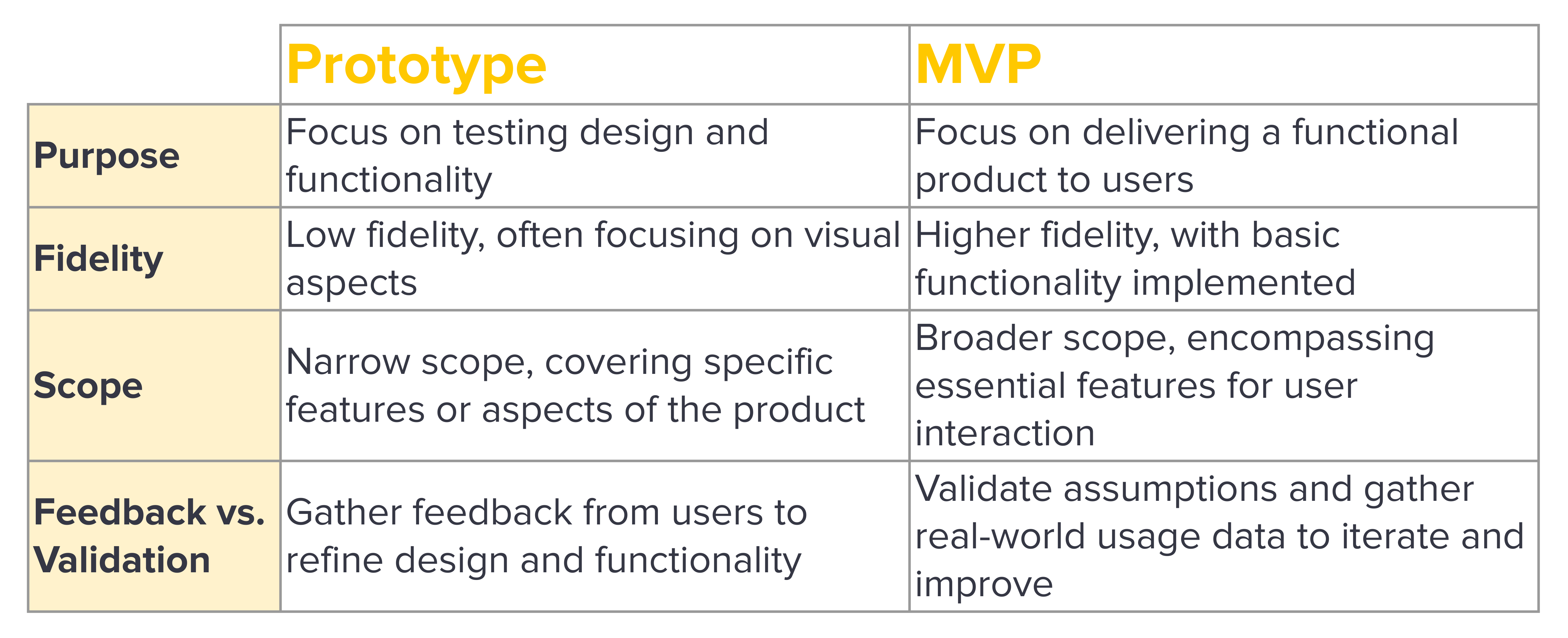One of the most common pitfalls that aspiring entrepreneurs fall into is rushing to develop their full product without first validating their assumptions and understanding whether their target audience truly needs their solution. This rushed approach often leads to a waste of time and resources.
Instead, they need to gather and process feedback quickly to validate assumptions and pivot their product early, if required, before investing in building a market-ready solution. One of the most effective methods of engaging with their intended audience is creating prototypes and minimum viable products (MVPs).
In this blog post, I will compare prototypes and MVPs, outlining their key differences and discussing when to use each one. To provide you with the most insightful perspective, I will also include the expert viewpoint of our CEO, Ari Hershowitz. With a proven 15-year track record of leading teams to modernize software systems in national legislatures and other government entities, his insights are invaluable.
Whether you’re an aspiring entrepreneur with the next big idea, a project manager guiding a client’s project, or simply curious about the product development process, this is your backstage pass. So, let’s dive in.
Overview
Prototype
A prototype is a preliminary version of a software product, typically focusing on design and functionality rather than full-scale implementation. It is a great tool for bringing ideas to life, testing concepts, and gathering crucial feedback from stakeholders.
Characterized by their low fidelity and emphasis on visual representation, prototypes offer a flexible canvas to explore different ideas and iterate rapidly using prototyping tools like Figma, Sketch, Uizard, Balsamiq, and MockFlow.
Prototypes come in various forms, from simple paper or digital sketches to more sophisticated digital interactive mock-ups.
Regardless of the medium, the primary objective remains unchanged: to validate design assumptions, refine the user interface, uncover usability issues, and improve the user experience before investing resources into full-scale development.
MVP
An MVP represents the most scaled-down version of a software product, containing just enough features to be deployed and tested. The focus is to deliver a functional product to end-users to test hypotheses and validate product-market fit in a real-world context.
Their lean and agile nature characterizes MVPs. They are developed following a rigorous process of prioritization, where features are evaluated based on their impact on the user experience and the product’s overall value proposition.
By focusing on the bare essentials and stripping away the rest, MVPs enable teams to validate assumptions, gather real-world feedback, and iterate based on user behavior and market response.
The main objective of launching an MVP is to measure user interest, collect usage data, and make informed decisions about future development priorities. It also is a powerful tool for attracting early adopters, validating business models, and securing investor interest.
Key differences

Here’s how our CEO, Ari Hershowitz, sees the difference between a prototype and an MVP.
“I think of the difference as testing feasibility (prototype) vs. usability (MVP).
A prototype is typically used to prove that the concept is realistic. I often use a prototype to prove that the hardest part of the technology is viable.
The purpose of an MVP is to prove the usability. An MVP often focuses on one task, out of many, that can be done better or more efficiently with the new tool. Some of the inputs and outputs may not be ideal to simplify the initial design and see if the user prefers the MVP to their old way of doing things.”
Whether working on a client’s project or trying to develop your product, it’s crucial to identify and set the project priorities. Once you do this, you can proceed with what will work best to test those priorities. Sometimes, it is with a presentation of a prototype of a simple, non-functional design and sometimes an MVP with functionality that can be tested out in a real-world context.
“A prototype is best applied with new, surprising, or challenging technology, where the user flow is less important than the outcome or where achieving an outcome can help move the project forward, for example, proving that a certain document type can be processed.
An MVP is best when there is a clear user or customer defined, and it is possible to get the product in their hands to test in early stages.”
Let’s look at some use cases where prototypes and MVPs can be used.
Use cases
Prototype
Early-stage product development

Prototypes are particularly valuable in the early stages of product development when ideas are still taking shape. During this phase, stakeholders explore various possibilities, and prototypes help transform abstract concepts into tangible representations, quickly test ideas, identify potential challenges, and iterate to improve.
For example, a team can start by drafting rough ideas in simple digital sketches or low-fidelity wireframes to visualize the basic workflow. At later stages of the ideation process, these sketches and wireframes may evolve into interactive mock-ups to showcase specific features or functionalities.
Exploring different design concepts

Prototypes provide a platform for experimenting with layout, color schemes, and typography. They’re a great way to test various design directions, discover innovative solutions, uncover design patterns that resonate with users, and refine the product’s visual identity without investing time and resources in making a functional product.
For example, a design team can create multiple versions of a prototype, each showcasing a different design concept or aesthetic approach, and conduct usability testing to assess the effectiveness of each design option. The prototype may then be iteratively updated to incorporate feedback from stakeholders until the team can identify which design approach will work best for the target audience.
User testing and feedback gathering

Gathering and incorporating user feedback is the only way to create software solutions that meet the needs and expectations of the target audience. Prototypes provide a quick way to gain insights into user experience through usability testing, surveys, and interviews. This approach ultimately leads to the development of more intuitive and user-friendly software.
For example, teams can conduct user testing sessions where participants interact with the prototype and provide immediate feedback on their experience. Qualitative and quantitative data gathered during testing sessions should be analyzed to validate design decisions and identify areas for improvement.
Technical feasibility assessment

Before committing significant resources to full-scale product development, teams may use prototypes to:
-
assess the technical feasibility of implementing certain features or functionalities, especially for projects involving innovative or complex technologies;
-
mitigate technical risks early to reduce the likelihood of costly delays or setbacks later on.
For example, a team can test specific technical components by building proof-of-concept (POC) prototypes to validate the feasibility of using a particular technology stack, integrating third-party APIs, or implementing advanced algorithms. During their work on the POC, they can see the potential roadblocks, evaluate alternative solutions, and make informed decisions about the viability of incorporating specific tech components into the final product.
MVP
Validating product viability

Developing an MVP allows teams to validate the viability of their product concept and assumptions and gather user feedback by testing its core functionality and value proposition in the real-world context. Launching an MVP will help assess whether there’s a genuine need for the solution and if users are willing to engage with it.
For example, a team can build the minimal set of features essential for delivering the product’s core value and launch it. As an MVP includes basic functionality that addresses users’ primary pain points or solves a specific problem, user feedback and traction (or lack of it) will help the team determine whether the product concept is viable and worth pursuing.
Testing market demand

An MVP is a tool for testing market demand by putting the product in front of potential users and observing their behavior and reactions. It’s about understanding whether the product has a market and whether users are willing to adopt it. This approach helps:
-
mitigate the risk of building a product that fails to resonate with the target audience;
-
assess if the demand is sufficient to justify further investment in product development.
For example, a team can release the MVP to a target audience or market segment and monitor key metrics such as user engagement, retention, and conversion rates. They will also need to consider user feedback, market trends, and competition. This will help validate their assumptions about target users, gather insights into their preferences and needs, and make informed decisions about future development efforts.
Attracting early adopters and investors

An MVP that addresses users’ primary pain points or solves a specific problem is a compelling and relatively low-cost way to showcase the product’s potential and attract early adopters willing to try out new solutions and provide feedback. The MVP that demonstrates early traction and user engagement can be attractive for investors looking to back promising startups and innovative ventures.
For example, teams can leverage the MVP to demonstrate the product’s value proposition and unique selling points to potential users, investors, and partners. This could involve marketing efforts, demo sessions, or participation in industry events and networking opportunities.
Iterative development based on real-world usage data

Iterative development backed up by real-world usage data and insights ensures that the product aligns with user needs and market dynamics. By learning from user behavior and feedback, teams can prioritize features and enhancements that impact user satisfaction and business outcomes.
For example, a team can collect and analyze usage data from the MVP, including metrics such as user engagement, feature usage, and conversion rates. In combination with the feedback from users solicited through surveys, interviews, and support channels, incorporating real-world usage data can increase the chances of building successful and sustainable products that meet the needs of their target audience.
Conclusion
Validating assumptions and gathering feedback early in the software development process is extremely important to avoid wasting time and resources on building products that may not meet the target audience’s needs. Prototypes and MVPs are effective methods for engaging with users and testing product concepts in real-world contexts.
Prototypes are ideal for early-stage product development, exploring design concepts, gathering user feedback, and assessing technical feasibility. On the other hand, MVPs are valuable for validating product viability, testing market demand, attracting early adopters and investors, and enabling iterative development based on real-world usage data.
By strategically leveraging prototypes and MVPs, you can increase your chances of building successful software solutions that address user needs, resonate with the market, and ultimately drive business success.
